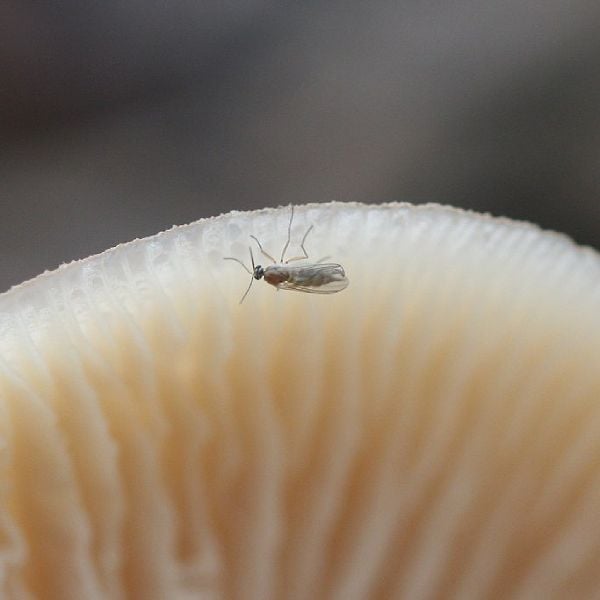How to Identify and Manage Fungus Gnats

For plant maintenance professionals, the worst pest problems are often the ones you don’t notice until it’s too late. A fungus gnat infestation is a prime example and can be particularly problematic.
Fungus gnats are common pests in the United States, found everywhere from greenhouses to interiorscapes. Attracted to damp environments where fungi thrive, they are the most common interior landscape pest due to how quickly their populations can grow. Because of their flying behavior, most clients are not tolerant of even a single fungus gnat and often expect immediate control. This is one pest where having a preventive treatment program in place is a smart move.
Why Fungus Gnats Are Harmful to Plants
While adult fungus gnats don’t feed directly on plant material, they can transmit plant pathogens as they fly from place to place. The larvae live in the soil and feed on the roots of plants and organic matter. Most larger plants can handle some feeding by fungus gnat larvae, but the damage can leave open wounds that make it easier for pathogens to move in.
How to Identify Fungus Gnats
Fungus gnat adults are small but relatively easy to identify. They have long legs and resemble tiny mosquitoes in both body shape and size (about 2.5 mm). Their wings are clear with a Y-shaped vein pattern. Although fungus gnats can fly, they often hop from place to place when on soil. Adults are gray or black in color.
Fungus gnat larvae are tiny, translucent, legless maggots with shiny black heads and can grow up to 8 mm long. These larvae live in the soil and are responsible for most of the damage caused by a fungus gnat infestation.

Don’t confuse fungus gnats with shore flies—another problematic gnat. Adult shore flies are similar in size (2.5 mm) but are stronger fliers, more stoutly built, and have short legs and antennae. They resemble small fruit flies, with black bodies, reddish eyes, and dark wings with five distinctive light-colored spots. These spots are key for identification and can easily be seen when the flies are at rest.
Shore flies tend to thrive in moister conditions than fungus gnats and can also be found around plant material. Unlike fungus gnat larvae, shore fly larvae do not cause direct damage to plants. However, under high populations, frass deposits can accumulate on plant foliage, reducing the visual quality of the plant.
Fungus Gnat Life Cycle
Adult fungus gnats live for just seven to ten days, but during that short time, a single female can lay up to 300 eggs. These eggs are laid in moist soil, where conditions support fungal growth. Once the fungus gnat eggs hatch, the larvae start feeding on plant roots and fungi near the surface of the soil. The larvae grow to about 8 mm long before entering the pupal stage. After pupating, the adult gnats emerge and begin the cycle again.
The length of a fungus gnat’s life cycle depends on temperature. At around 80˚F, they can complete their entire development—from egg to adult—in as little as 12 days.
Do You Have a Fungus Gnat Infestation?
Clear indicators include:
- Adult fungus gnats trapped on yellow sticky cards
- Cream-colored larvae visible in the soil
- Presence of fungus gnat larvae feeding on potato wedges placed in the soil as a diagnostic tool
To use the potato test, insert a wedge into the soil and check it after a day or two. If larvae are present, they’ll be clearly visible on the surface of the potato. Don’t leave the potato in the soil for more than a few days, as it can begin to rot or attract other pests.
How to Get Rid of Fungus Gnats
Because fungus gnats thrive in moist conditions, it’s important not to overwater plants. Allow the top layer of soil to dry out between waterings to discourage fungus gnat infestations. Keep in mind that removing the top layer of soil will not help with long-term management.
A highly effective treatment option is beneficial nematodes—microscopic worms that are applied to the soil with water. The species Steinernema feltiae works extremely well against this pest. These nematodes target fungus gnat larvae, preventing the gnats from completing their life cycle. Once applied, you likely won’t see a decline in the adult population for about a week, unless you’re also trapping them. For adult control, yellow sticky cards are a great tool to trap flying gnats and prevent them from laying more eggs.
If you’re also dealing with shore flies, nematodes can help here, too, but S. feltiae is not the best option. This species uses a “cruising” foraging strategy, moving throughout the soil to seek out larvae like those of fungus gnats. Shore fly larvae, however, tend to stay near the surface of the soil. In these cases, Steinernema carpocapsae—an ambush forager that remains near the surface—is a better fit.
Repeat applications of beneficial nematodes may be needed to fully eliminate these pests. And if fungus gnats are a recurring problem, a preventive program might be needed.
Preventing Fungus Gnat Infestations
The best way to prevent a fungus gnat infestation is with smart watering practices and a preventive drench program using beneficial nematodes. These microscopic allies can keep an outbreak from ever happening. Just be sure to talk with your nematode supplier about frequency of application. Fungus gnats can be tough to get rid of once an infestation has taken over your account, so early detection and prevention are important.
Battling other common indoor plant pests? Check out my guide below for tips on managing spider mites, whiteflies, thrips, mealybugs, aphids, and scale insects.
Fungus gnat photo courtesy Arthur Chapman
You May Also Like
Leave a Reply
You must be logged in to post a comment.



















